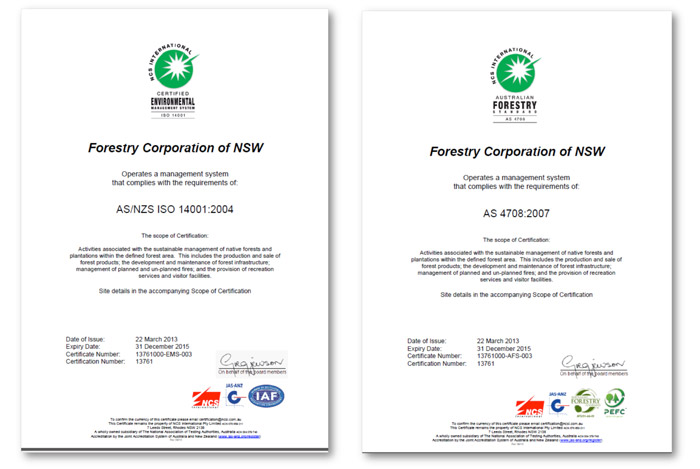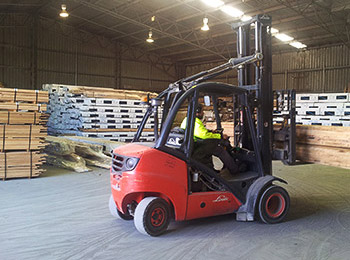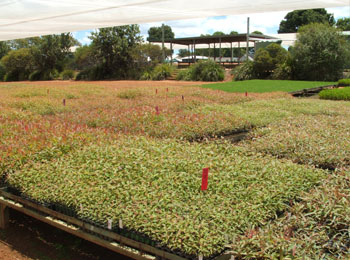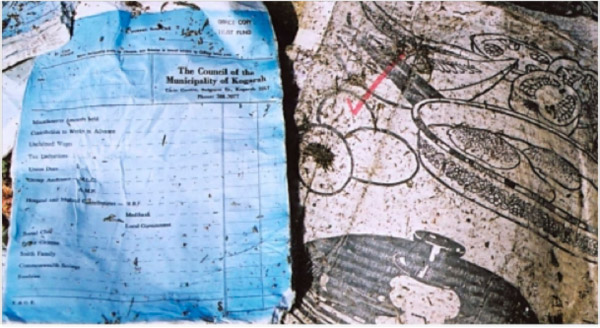1. Certified & sustainably managed
Nearly all New South Wales timber is certified by an internationally recognised standard, such as the Australian Forestry Standard (AFS) or the Forestry Stewardship Council (FSC).
Certification provides assurance that the forest products are legally sourced and that forest management is structured to encompass environmental, economic and social values and outcomes. By buying New South Wales timber, you are almost guaranteed the resource will be harvested from certified forests.
Chain of Custody Certification is the formal process of tracing wood and forest products from a certified forest to its place of market. So when buying timber, always ask about its origin as well as chain of custody certification.
For more information, please visit www.forestrystandard.org.au.
Figure 1 – Forestry Corporation of NSW, Forest Management Certification
2. Supports regional jobs & local economies
By buying NSW timber you are supporting jobs in a sustainable domestic industry that is based on sound environmental practice. The NSW forest industry employs more than 22,000 people in a diverse array of fields in forest management, harvesting and transport, primary processing, manufacturing, logistics and marketing.
3. Renewable & recyclable
The forests that produce NSW timber are renewable. Every time a tree is harvested up to ten trees are re-established in its place. Native timbers are produced on a continuous 60-to-100 year cycle, while the rotation length for plantation timbers ranges between 26 and 45 years.
Being organic, timber products are easy products to recycle and reuse.
Many New South Wales timbers are durable so when old homes or commercial buildings are demolished the timber they contain can often be re-used. Some New South Wales businesses specialise in recycling and reclaiming timber flooring, decking, feature cladding, posts, beams and stair treads.
Timber in New South Wales that cannot be reused is often recycled into wood chips. Chipping facilities service a broad range for markets including horticultural, agricultural and urban amenity products as well as reconstituted wood products. Woodchips can also be used to produce renewable energy for heat, power and biofuel.
The Visy pulp and paper plant at Tumut is a model recycler. It uses wood waste to run its boilers and sawmill residues. Recycled paper products are key components of its primary feedstock (refer Figure 2).
Figure 2 – Visy Pulp and Paper’s mill at Tumut is the State’s largest recycler of paper and magazines
Where timber products reach the end of their in-service life they are typically buried in municipal landfills. As buried products their role as carbon storage vessels continues for a very long period of time (refer Figure 3).
Figure 3 – Paper retrieved from a NSW landfill after 20 years remains in pristine condition.
Source Ximenes, F. (2008) Carbon in Forest Products: The Opportunity
4. Climate friendly
Did you know that half the dry weight of timber is carbon? Carbon is captured and stored as a tree grows through the process of photosynthesis. When a tree is harvested the carbon remains in the timber products.
Being a naturally made, timber requires very little energy to produce. For example, it takes eight times less energy to produce a tonne of timber than it does a tonne of steel or 46 times less energy than a tonne of aluminium.
There have been numerous studies make clear the climate mitigation benefits of using timber. Research by the CRC for Greenhouse Accounting showed that if half of Australia’s new homes were built using mainly timber products, more than 1.3 million tonnes of CO2 emissions could be saved per annum.
5. Versatile & easy to use
Timber is inherently versatile and easy to use. It can be sawn, peeled, sliced, split, chipped, planed, shaped, moulded, sanded, drilled, nailed, screwed, painted, treated or simply left in its natural round form.
Buildings made from timber are easy to erect and take a third less time to build as the same structures made from concrete, bricks and mortar.
People who work with timber from carpenters to cabinetmakers and millers to musical instrument makers all appreciate timber’s natural workability.
6. Unique properties
New South Wales has arguably the world’s greatest range of home grown timbers.
Softwood plantations produce large quantities of exotic pine timber that is uniform, light and easy to work. Pine is the timber of choice for house frame and truss builders.
There are around 50 commercial timber species which grow naturally within New South Wales. The majority of these species are hardwood eucalypts which are renowned for their strength, durability and features. The State’s hardwood eucalypts come in a broad array of colours, from rich reds and pink browns to light browns and pale straw.
All timbers have good acoustic and thermal insulation properties and low embodied energy which makes them highly energy efficient.
7. Suits every application
There is a New South Wales timber product to suit every application.
The attractive feature and toughness of New South Wales hardwood eucalypts makes them highly suitable for flooring and decking and other products that people like to have on display in their homes and offices.
Hardwoods are also well suited to outdoor applications due to their strength and natural durability. Transmission poles, timber bridges, wharves and jetties are all made from highly durable New South Wales hardwoods. The toughness of hardwood makes it well suited to industrial applications like pallets and mining timber props.
Reconstituted hardwood is made into weatherboard cladding products which are renowned for their durability and versatility. Hardwood chips are used to make high quality writing and photocopy paper.
Cypress pine is a softwood timber that grows naturally in western New South Wales. Cypress pine is recognised as one of the world’s most termite resistant timbers and has been widely used to clad the floors and walls of many Australian homes.
For most industrial scale applications pine is usually the timber of choice. It is well suited to making newsprint, cardboard, MDF, particle board, plywood and engineered wood products. Modern engineered timber products such as laminated veneer lumber (LVL) and glue laminated timer (glulam) can be manufactured to meet specific structural requirements.
Lightweight pine timber framing methods are now being employed in high rise buildings such as the Forté apartment in Melbourne. This is Australia’s first high rise apartment building made from Cross Laminated Timber (CLT). At ten stories it is the tallest of its type in the world.
8. Dependable
When selecting timber for a specific application it is important to know that it will be fit for purpose. Strength, durability and appearance are all issues to consider.
Timber is graded for durability and strength. Stress grades and timber sizes combine to determine the spanning ability of load carrying timbers. A series of Australian Standards provide details of the differing structural properties of different timbers.
For more information on timber specifications see www.tdansw.asn.au.
9. Safe & healthy
Timber has a range of health and safety features which are not always available in alternative products. Timber is natural product that has low toxicity, is easy to keep clean and is tactile. Timber doesn’t conduct electricity and, as an insulator, it helps a room to warm up quickly and to maintain optimum humidity balance.
Unlike steel, timber is an age-old product that behaves predictably in a fire. If timber catches fire it will first create a charred surface that provides protection to its inner core. This feature allows the timber to remain intact during a fire for longer than alternative products.
10. Cost effective
Timber is cheaper than alternative products like steel, bricks, concrete and tiles. It is also less prone to price fluctuations. Due to a large number of readily available timber species and grades one can be selected to suit the requirements of most designs and budgets.






